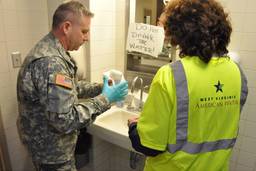
When “welfare reform” passed in 1996, the economy was in relatively good shape and welfare moms entered the workforce in significant numbers. I knew some people for whom this was their first opportunity to bring in a paycheck, and their self-esteem soared, even if the jobs were low-paying and mostly dead-end.
But I was suspicious from the beginning of a law — officially “The Personal Responsibility and Work Opportunity Reconciliation Act of 1996” — that measured its success not by the number of single mothers gaining employment, but by the drop in the number receiving welfare.
Now there’s data to back up my suspicion, data that helps to answer an important question: Now that the national unemployment rate has climbed to almost double digits, how are these women faring?
Statistics from the Center on Budget and Policy Priorities are pretty grim. They show that the number of non-employed single mothers dropped from 3.7 million in 1995 to 2.6 million in 2000, then rose to 3.2 million in 2005. By May 2009, the most recent single month for which data is available, the figure had jumped to 3.5 million — almost back to pre-welfare reform levels.
Arloc Sherman, a senior researcher with the CBPP, explains:
We know that during the economic boom of the ‘90s – which coincided with other kinds of new help for low-income working families – a lot of single parents went to work, and yet, even in the late ‘90s, more people lost help than went to work. And since 2000, the trend has been more troubling. Employment levels of single parents went down and the amount of help they got continued going down.
Federal requirements limited recipients to two years of consecutive benefits, with a lifetime limit of five years. But states were given a lot of leeway in how they implemented the new law, which changed the federal welfare program’s name from Aid to Families with Dependent Children to Temporary Assistance for Needy Families.
Connecticut, for example, cut off benefits after just 21 months — the strictest time limit in the country — although the state provided more generous non-monetary assistance than many other states, including healthcare and child-care payments.
Kim Clark’s life has followed a similar pattern. Clark lives in New Haven and was receiving welfare under the old system for herself and her son, who was born in 1982. Twenty-one months after the new law took effect in 1997, she was able to get a couple of jobs in quick succession, despite having a felony record (for shoplifting); she did telemarketing and worked at Burger King.
Clark had a second son in 2002, and got back on welfare. When her 21 months were up, she was again able to land jobs easily – until 2005.
“It’s only through the help of my family that I’ve been able to keep my head above water,” she says. “But in 2008, I lost my apartment and ended up in a homeless shelter.”
Clark’s now living in transitional housing, where she has 10 more months before she has to move out. With no job and few prospects, she’s not sure what she’s going to do. “Since ’05, I’ve put myself out there, with no results. I’m a very good worker,” she says. “If people were hiring, I’d have a shot to get in.”








